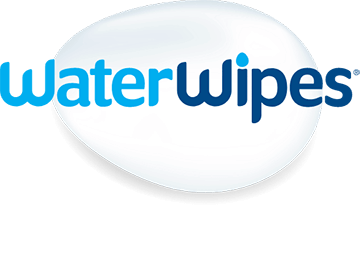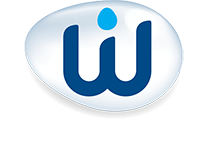WaterWipes: Made with 99.9% high purity water
We recommend that healthcare professionals should be aware of the ingredients contained in baby wipe products. Made from 99.9% high purity water and a drop of fruit extract, WaterWipes have been specifically developed to be as mild and pure as cotton wool and water.
WaterWipes are a non-medicated wipe and contain minimal ingredients They are manufactured using a unique technology within cleanroom conditions, allowing them to produce a gentle and effective baby wipe without adding unnecessary ingredients.
WaterWipes provide gentle cleansing for delicate newborn skin. Our baby wipes are so gentle they can even be used on premature babies. We are proud to be the preferred baby wipes permitted for use on premature babies in the Neonatal Intensive Care Unit at the National Maternity Hospital Foundation.
Why is a pure and gentle baby wipe with minimal ingredients so important for baby skin?
The unique properties of baby and infant skin
TThe skin is the body’s largest organ and has three primary functions: protection, regulation, and sensation. It consists of three main layers – the epidermis, dermis, and subcutaneous fatty tissue.
The epidermis is further divided into the stratum corneum, stratum lucidum, stratum granulosum, stratum spinosum, and stratum basale. The stratum corneum is the outermost layer and acts as a protective barrier against microorganisms, chemicals, and allergens. Significant clinical evidence stresses the importance of the stratum corneum and its barrier function for babies, especially neonates.1
The epidermis in babies is 20% thinner and the stratum corneum is 30% thinner,2 which increases susceptibility to permeability and dryness.3 From birth, barrier function and the water-handling properties of the stratum corneum are continuously optimized, and the properties that make infant skin unique are thought to persist through at least the first 12 months of life.1 Baby skin is also less firmly attached than mature skin and has a higher propensity to increased trans-epidermal water loss and reduced stratum corneum hydration, so it has a less effective skin barrier function.3,4,5
As the ratio between baby body surface to baby body weight is higher, topical agents are more readily absorbed and can therefore have a more pronounced effect on baby skin.3 All these factors combine to make neonate and infant skin a less effective barrier, making it more vulnerable.
It is important to select the correct ingredients for use on babies to help prevent diaper rash, minimize skin conditions such as eczema, and preserve the skin barrier function. The National Institute for Health and Care Excellence (NICE) Guidelines also note that medicated wipes should not be used.6
Understanding common wipe ingredients
It is recommended that topical agents used for cleansing babies should not adversely alter or affect the protective skin barrier. When choosing products for infant and newborn skin, it is important that they are:
pH suitable
Only contain mild preservatives
Fragrance-free
Alcohol-free
Soap-free
Fragrances and preservatives are the two most clinically relevant allergens in personal care products. Legally, all cosmetic and personal care products must include a list of ingredients.
Consumers are increasingly demanding products with minimal ingredients. However, as seen in the table below, standard baby wipes on the market an average of 12 ingredients. WaterWipes only has two ingredients so is the ideal choice for your baby.
The diagram below outlines a list of ingredients often found in standard baby wipes. When different ingredients are present, emulsifying agents are sometimes needed to help them mix together evenly. A buffer may be required to maintain the pH levels and sometimes a thickening agent is used to ensure the solution has the right viscosity. This is why it is hard to create a formula with a small number of ingredients.
What makes WaterWipes different to other baby wipes?
Here are a few reasons why WaterWipes is the best choice for your baby:
WaterWipes are made from 99.9% high purity water and a drop of fruit extract.
Fruit extract is naturally derived and acts as a gentle skin conditioner.
It is soap and fragrance free to help reduce the risk of drying out the skin and the potential development of contact dermatitis.
Several clinical studies, overseen by dermatologists, demonstrate that WaterWipes have good skin compatibility, are non-irritating and non-sensitising.7
WaterWipes is proud to have numerousglobal accreditations, sponsorships, endorsements, and registrations, including:
The Vegan Society
Why choose our baby wipes?
WaterWipes are the world's purest baby wipes. They are gentle and kind to your baby's skin. WaterWipes only have two ingredients, water and a drop of fruit extract. You can use our baby wipes safely on sensitive, premature, and newborn skin.
Last updated: 16/10/2023
References
Nikolovski, J., Stamatas, G., Kollias, N., Wiegand, B., 2008. Barrier function and waterholding and transport properties of infant stratum corneum are different from adult and continue to develop through the first year of life. Journal of Investigative Dermatology 128, 1728–1736. Available at: https://www.sciencedirect.com/ Last accessed April 2019
Stamatas, G., Nikolovski, J., Luedtke, M., et al, 2010. Infant skin microstructure assessed in vivo differs from adult skin in organization and at the cellular level. Pediatric Dermatology 27, 125–131 Available at: https://www.ncbi.nlm.nih.gov/ Last accessed April 2019
Cooke, A, Bedwell, C, Campbell, M, et al. Skin care for healthy babies at term: A systematic review of the evidence. Midwifery 56 (2018) 29–43 Available at: https://www.midwiferyjournal.com/ Last accessed: Last accessed April 2019
Oranges, T., Dini, V., Romanelli, M., Skin Physiology of the Neonate and Infant: Clinical Implications. Advances in Wound Care 2015: 4(10): 587-595. Available at https://www.ncbi.nlm.nih.gov/ Last accessed April 2019
Nakagawa, N., Sakai, S., Matsumoto, M., et al , 2004. Relationship between NMF (Lactate and Potassium) content and the physical properties of the stratum corneum in healthy subjects. Journal of Investigative Dermatology 122, 755–763. Available at: https://ac.els-cdn.com/ Last accessed April 2019
NICE. Postnatal Care up to 8 Weeks after Birth (subsection – Maintaining Infant Health, Section 1.4.23 – Skin)
Data on file. Conducted by an independent testing laboratory

